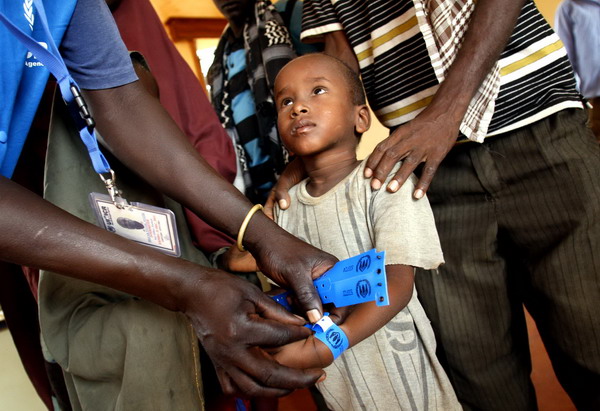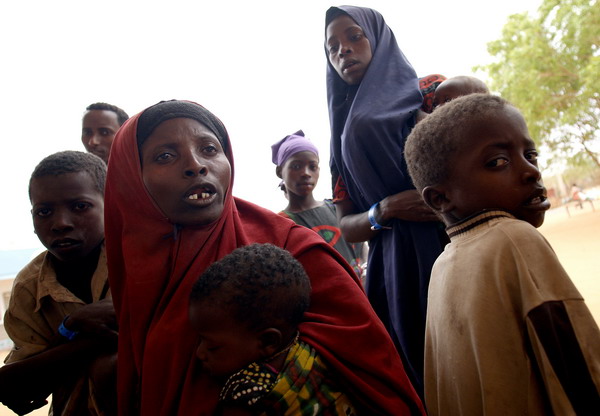A place of refuge for people in despair
Updated: 2011-11-01 07:42
By Li Lianxing (China Daily)
|
|||||||||
|
 The wristband with a blue tag signifies this boy has been processed by the United Nations High Commissioner for Refugees to take shelter with his family at one of the Dadaab refugee camps in Kenya. [Photo by Zhang Wei/China Daily] |
After a 30-minute reception, health check and submitting a bio-fingerprint, Sahra Ali Mohamed and her seven children were given blue wristbands by the United Nations High Commissioner for Refugees (UNHCR).
They arrived at the refugee camp without any belongings, not even a cooking pot, after a five-day bus journey from Jilib in southern Somalia, where the Transitional Federal Government fought the Islamic Courts Union in 2006 and 2007.
Mother and children wait quietly and patiently to collect food from the United Nations World Food Program.
They will soon be officially registered as residents of Dadaab refugee camp in northeastern Kenya, the largest in the world.
The camp is home to nearly 463,000 refugees, 98 percent of them from Somalia. More than 1,000 refugees arrive daily. Monthly arrivals peaked at 40,434 in July. In January, it was 9,861.
Her husband is not with her. He was forced to stay behind as the bus was full. They promised to meet later in the camp.
"I couldn't stay at home any longer. My family would have all died because we didn't have any food at home," she said.
She didn't know that Dadaab also faces severe shortages, of food and space. It has been more than full for some time.
Dagahaley, Ifo and Hagadera camps were established in Dadaab in 1991 to accommodate about 90,000 refugees. Nearly 463,000 people live there now, so extensions were built in Kambioos, Ifo East and Ifo West.
|
 Sahra Ali Mohamed and her seven children arrive in Dadaab as refugees from Somalia. [Photo by Zhang Wei/China Daily]
|
Jam-packed
Dadaab used to be in the middle of nowhere. The town itself is just one street, a kilometer long, with some shops, garages and offices. But it has become the third most populous city in Kenya.
UNHCR's tents and wooden shelters are packed onto this land, and the quality and quantity of food distribution, healthcare and education in the camps have been heavily compromised by the sheer volume of new arrivals. For many residents, camp life is a struggle.
Kheyro Adan Abdi lives in a 3-square-meter shelter in Ifo, the largest of the camps. She tried hard to move out from the sitting mat to talk to visitors, but failed. She slouched back next to her small cooking pot, which held some spaghetti with sugar for her family of seven.
"I don't have any energy and my headache is really killing me," she said.
Abdi, her husband and five children arrived at the camp two months ago after walking for 30 days to the Kenyan border. If the UNHCR staff hadn't found them and given them food when they crossed the border, they may have died from starvation before arriving at the refugee camp.
Abdi felt ill a month ago. She went to the only hospital in Ifo camp and got some tablets, but not a diagnosis, she said.
"The tablets just didn't work and I am getting worse," she said. "Now I'm not even thinking about going back again, as there are very long queues and useless medicine."
She said life in the camp is tough and the food is insufficient for her family. Would she return to Somalia? She replied with six nos.
"Not enough here is much better than nothing at home."
Struggle for more
Don Owino, an employee at the local World Food Program office, said the program's ration is enough for families to receive the required minimum of 2,100 kilocalories a person a day. Groups at particular risk can receive fortified rations.
Still, malnutrition remains a great threat to many vulnerable people, particularly children and young mothers.
"From a comprehensive nutritional survey in Dadaab in August, the rates of acute malnutrition had reached between 17 percent and 22 percent, which was above the emergency threshold of 15 percent," Owino said. "New arrivals in Dagahaley, for example, registered global acute malnutrition rates of 38 percent and severe acute malnutrition of 20 percent."
The program also has blanket supplementary feeding for all children 6 months to 5 years old. Each gets a portion of Super Cereal, a fortified blend of maize and soy that is higher in protein and micronutrients than traditional cereals.
"Now we are providing Plumpy Sup to vulnerable groups," Owino said. "It is a specialized peanut-based paste enriched with essential vitamins and minerals and used in treating children diagnosed with moderate acute malnutrition. It does not require cooking, which makes it easier for refugee families to manage."
Abdi is worried about her children's future, not her own. The extreme crowding means only two of her five children can go to school.
The UNHCR said there is a conspicuous scarcity of infrastructure, teaching and learning materials such as classrooms, desks and books. As a result, only 47,358 out of the 140,605 children of school age can go to school in the camp.
No jobs allowed
Dadaab refugee camp is not a camp at all, but an expanding community without productivity or means to sustain itself.
If refugees stay put in Kenya, integrating into local society is not possible. The Kenyan government's encampment policy forbids refugees from having gainful employment or moving freely around the country, although small markets and herds can be found in the camp.
"In Ugandan refugee camps, refugees are normally allocated a small piece of land to be self-reliant. But here, they have no land to grow crops," said Lydia Wamala, information officer of the food program's Uganda office.
Katima Abdi and her husband have been living in Dagahaley area for 22 years. They arrived alone, but now have five children.
"We have tried to find work to do but there is no chance at all," she said. "My husband went insane a few year ago because of our hard situation."
Security
Twenty years ago, Hassad Aigale was a 6-year-old local boy living in Dadaab with his parents, and he says the town was a simple and peaceful place. Now he works for UNHCR at the reception center in Ifo camp.
He says the huge number of refugees in his hometown have brought some "negative implications", because locals and refugees are sharing the same land, the same resources and the same environment. Robberies, murders and kidnappings occur in the camps, he said, and locals are particularly concerned about security.
Under severe pressure from various sides, the Kenyan government established a refugee affairs department to take more control of what is happening in its own territory. The UNHCR and Kenya's Department of Refugee Affairs jointly staff the reception desk.
Kenyan President Mwai Kibaki, speaking at the United Nations on Sept 20, called on the international community to assist the Somalis in their country. That would curb the flood of refugees, as well as undesirable elements, to his country.
In the middle of October, Kenya sent troops across the border to pursue the Islamist militant group al-Shabaab and clashed with them inside Somalia for the first time, according to British Broadcasting Corp. Somalia's president, Sheikh Sharif Ahmed, opposed the incursion, and al-Shabab has threatened reprisal attacks in Kenya.
The worst drought in 60 years is a significant contributor to the influx of refugees, but the root cause is Somalia's dire security situation. That is why this camp was built in 1991 - refugees had already settled there - when the civil war broke out in Somalia.
No comment
Even though they have migrated and settled down in the camp, refugees are unwilling to comment on the situation back home. They say that the fight between al-Shabaab and the Transitional Federal Government did not affect their decision to leave Somalia.
"Of course they are afraid of talking about the al-Shabaab in the camp, because no one knows if your neighbor or friend is one of them," said a UN camp security official who wished to remain anonymous.
Several killings in the camp are thought to have been revenge by al-Shabaab against informers. "Although there is still no convincing evidence to prove these allegations, the security situation in the camp is serious now," the official said.
For Katima Abdi, the longtime camp resident, there are only two choices: to wait for resettlement by UNHCR to Western countries such as the US, Canada and in Europe, or to return home when "peace comes to Somalia".
How likely is the second option? "From the overwhelming new arrivals everyday," she said, "I know things are deteriorating in Somalia."











